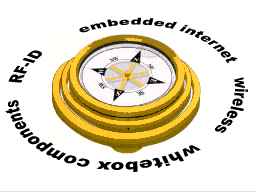|
|
Choose
four:
|
Jan 1999 version |
Lost in the technology sea? You're not alone. To help you finding the way
back to home, here's my technology compass:

l make my choice according to how
stimulating, interesting, elegant, open minded and fun (yes, fun) a technology
is. This way, I won't be bored: all bored designers I know make boring products.
And why should your customer invest his time and money in a boring thing?
Facts is, designers have different literal definitions of what an "interesting"
thing is, but on the average they agree distinguishing what is "interesting"
and what is not.
The compass shows four hot technologies:
embedded internet is an hot topic these days (1998). It is not clearly understood how to embed the internet in everyday's products: who can tell me what a microwave oven and the internet have in common?
| Nonetheless the idea is appealing (and
intriguing), and many products (as vending machines, photocopiers, videocameras,
HVAC, etc.) can benefit immediately from the net. Not to mention the unavoidable revolution on TV, phones, office equipements. Like King Mida the net turns in gold everything it touches. |
five embedded examples: ... a soft drink dispenser calls when it's time to refill it ...an industrial machinery allows for remote servicing, programming, and emergency reconfiguration ...a surveillance camera interacts with the alarm system and sends a fire picture to the fire brigade ...a wirstwatch monitors our blood pressure, temperature, heart rate, sudoration, and calls for help in case of accident, disease or violence. ...a laser printer/copier knows when new toner is needed, automatically asks suppliers for the best quote, then buys at the best price. |
What do you need to be net-ready? Not much. Some libraries to call, at least 30KB of code space and a serial port, an off-the-shelf modem, plus a web-browser interface built from Java libraries. To get inspired, start visiting www.emware.com , www.spyglass.com, www.ireadyco.com , www.qnx.com, www.ussw.com .
Make it smaller, cheaper, and wireless.
And today, wireless is simpler than ever. The market demand for off-the-shelf
solutions for remote controls of any kind made it possible to have TX and
RX modules ready to be interfaced to your project.
"Wireless" is a magic word that makes totally new sense when coupled
with networking technologies. Each of the five embedded internet examples
above would benefit from a wireless connection to the intranet or the internet.
Even if your project is not net-centric, it is often convenient to free the
user from even the simplest cable. Not surprisingly, more and more companies
now offer off-the-shelf RF modules (whitebox components) so you don't have
to be an RF guru to complete a true wireless project. Check www.aurel.it,
www.radiometrix.com, www.linx.com.
My pages reflect my inclination
to whitebox components. You use a whitebox component every
time you use a wall-vart power supply, a 16x2 LCD module, an RF tuner or a
Basic Stamp. These components increase the abstraction level: you think at
the functions they include, instead of how are they implemented. In
the same way, you think to an IC in terms of simple logic functions, not as
a complex transistorized subcircuit.
Not surprisingly, successful wireless modules and RF-ID modules are good examples
of whitebox components. To cope with the increasing complexity and sophistication
of today's machines, we must semplify the underlying structure to make it
manageable by humans: increasing the abstraction level is therefore
unavoidable.
Being standardized and industrially engineered, whitebox components
give you high quality, uniformity, choice of suppliers, short time-to-market
and low cost. If your typical production is less than 10.000 units/year, they
are ofter cheaper than an internal-engineered solution. I expect the number
of such components to increase in the next years.
See also my article on Circuit Cellar Ink to know more about whitebox components.
I keep some RF-ID
samples (aka transponders) in my main desk's drwer. I don't
have a project using them (yet), but I love them. My samples are a credit
card sized transponder, a button-shaped one, some different diameter discs,
and small glass cylinder. They have an unique code and eeprom memory that
can be read or written at a distance up to 60 cm.
The number of applications is incredible. Identifications of animals,
transportation, inventory systems, access control, vehicle maintenance, waste
recycling, manufacturing, are just a few examples, more being invented every
day.
Now this technology seems mature and prices are low. For example, a sokymat
reader kit is sold at about $100, more or less the price of simple barcode
readers
Philips, Temic (now Atmel) and Texas Instruments (Tiris) are among the
big players in this new promising market, but also smaller firms as
www.emmarin.com, www.sokymat.com
are rapidly taking place.
|
